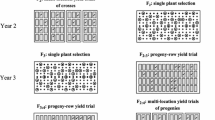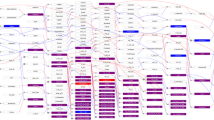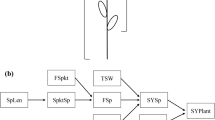Abstract
Breeding value refers to the ability of a genotype to produce superior progenies when crossed with other genotypes and are used to predict the performance of a genotype as a parent in plant and animal breeding. The objectives of this study were to estimate the breeding values of genotypes for cane yield, to determine the proportions of elite female and male parents, and evaluate their implications for sugarcane breeding. Families produced from crossing were planted in field trials using a randomised complete block design with three replications across seven regional breeding programmes from 2010 to 2015. From the first 20 progenies per plot, cane yield was estimated from stalk number, stalk height and stalk diameter that were subjected to best linear unbiased prediction analysis. Significant (P < 0.05) female and male variances indicated that the large variability observed among progenies could be attributed to the variability among genotypes used for crossing. Genotypes 82H0397, 85H0428, N52, B74713, 87W0629, 01G1662, 88W1323, 02K1657, 87L0573, 97E0474, N31, 93E0888, 03U1030, 06T3608, 96W0246, WI82498 and 79F0779, with high breeding values, produced progenies with high cane yield when crossed with diverse parents, which indicated broad general combining ability. The proportions of genotypes with high breeding values were higher for the coastal short cycle high potential (29.4%), coastal long cycle high potential (28.0%), humic soil (27.8%) and irrigated (26.0%) populations compared to the sandy soil (22.9%), coastal short cycle average potential (21.0%) and coastal long cycle average potential (18.4%) populations, probably due to longer cycles of recurrent breeding and selection. Low numbers of genotypes with high breeding values suggested that intensive evaluation and development of genotypes, used for crossing, are required in these populations.
Similar content being viewed by others
References
Atkin FC (2010) Estimates of breeding value of sugarcane clones and their impact on efficient parent management and cross pollination. Sugar Research Australia Limited, Indooroopilly, p 28
Atkin FC, Dieters MJ, Stringer JK (2009) Impact of depth of pedigree and inclusion of historical data on the estimation of additive variance and breeding values in a sugarcane breeding program. Theor Appl Genet 119:555–565
Balzarini MG (2000) Biometrical models for predicting future performance in plant breeding. PhD Dissertation. Louisiana State University, Louisiana, USA. Biometrics vol 44, pp 705–715
Barbosa MPH, Peternelli LA, Silveira LCI (2001) Plot size in sugarcane family selection experiments. Crop Breed Appl Biotechnol 1:271–276
Chang YS, Milligan SB (1992a) Estimating the potential of sugarcane families to produce elite genotypes using univariate cross prediction methods. Theor Appl Genet 84:662–671
Chang YS, Milligan SB (1992) Estimating the potential of sugarcane families to produce elite genotypes using bivariate prediction methods. Theor Appl Genet 84:633–699
De Carvalho ADF, Neto RF, Geraldi IO (2008) Estimation and prediction of parameters and breeding values in soybean using REML/BLUP and Least Squares. Crop Breed Appl Biotechnol 8:219–224
De Souza VAB, Byrne DH (2000) Predicted breeding values for nine plant and fruit characteristics of 28 peach genotypes. J Am Soc Horticult Sci 125:460–465
Freund RJ, Wilson WJ (2003) Statistical methods. Academic Press, New York, pp 3–1187
Heinz DJ, Tew TL (1987) Hybridization procedures. In: Heinz DJ (ed) Developments in crop science 11: sugarcane improvement through breeding. Elsevier, New York, pp 313–342
Henderson CR (1977) Best least unbiased prediction of breeding values not in the model for records. J Dairy Sci 60:783–7
Henderson CR (1984) Applications of linear models in animal breeding. University of Guelph, Ontario
Jackson PA (2016) Maximising the rate of parental improvement in the Australian Sugarcane Breeding Program. Sugar Research Australia Limited, Indooroopilly, p 120
Kimbeng CA, Cox MC (2003) Early generation selection of sugarcane families and clones in Australia. A review. J Am Soc Sugar Cane Technol 23:20–39
Lichakane M, Zhou MM (2016) Variance components, broad sense heritabilities and predicted selection gains for Eldana saccharina borer damage among coastal long cycle sugarcane populations. Proc South Afr Sugar Technol Assoc 89:275–285
Mbuma NW, Zhou MM, Van der Merwe R (2019) Evaluating parents for cane yield in sugarcane breeding using best linear unbiased prediction analysis of progeny data derived from family plots. South Afr J Plant Soil 36:21–28
Milligan SB (1988) The genetic variance-covariance structure of the Louisiana sugarcane breeding population. Dissertation, Louisiana State University and Agricultural & Mechanical College, p 120
Moreira EFA, Peternelli LA (2015) Sugarcane families selection in early stages based on classification by discriminant linear analysis. Revista Brasileira De Biometria São Paulo 33:484–493
Nuss KJ (1998) Aspects considered in the search for new farms for the experiment station. Proc South Afr Sugar Technol Assoc 72:42–45
Piepho HP, Mohring J, Melchinger AE, Buchse A (2008) BLUP for phenotypic selection in plant breeding and variety testing. Euphytica 161:209–228
SAS Institute (2014) SAS/STAT user’s guide, version 9.1.3. SAS Institute, Cary
Skinner JC, Hogarth DM, Wu KK (1987) Selection methods, criteria and indices. In: Heinz DJ (ed) Sugarcane improvement through breeding. Elsevier, New York, pp 409–453
Sreenivasan TV, Ahloowalia BS, Heinz DJ (1987) Cytogenetics. In: Heinz DJ (ed) Sugarcane improvement through breeding. Elsevier, Amsterdam, pp 211–251
Stringer JK (1999) Best linear unbiased prediction as a method for predicting cross potential. Sugar Research Australia Limited, Indooroopilly, p 12
Stringer JK, Cox MC, Atkin FC, Wei X, Hogarth DM (2011) Family selection improves the efficiency and effectiveness of selecting original seedlings and parents. Sugar Tech 13:36–41
Stringer JK, McRae TA, Cox MC (1996) Best linear unbiased prediction as a method of estimating breeding value in sugarcane. In: Wilson JR, Hogarth DM, Campbell JA, Garside AL (eds) Sugarcane: Research towards efficient and sustainable production. CSIRO Division of Tropical Crops and Pastures, Brisbane, pp 39–41
Vivek BS, Girish Kumar Krishnaak V, Vengadessanal R et al (2017) Use of genomic estimated breeding values results in rapid genetic gains for drought tolerance in maize. Crop Sci. https://doi.org/10.3835/plantgenome2016.07.0070
White TL, Hodge GR (1989) Predicting breeding values with applications in forest tree improvement. Kluwer Academic Publishers, Dodrecht
Zhou MM (2014) Family evaluation for sugarcane yield, using data estimated from stalk number, height and diameter. J Crop Improv 28:406–417
Zhou MM (2015) Selection for Eldana saccharina borer resistance in early stages of sugarcane breeding in South Africa. Am J Plant Sci 6:2168–2176
Zhou MM, Joshi SV (2012) Trends in broad sense heritability and implications for sugarcane breeding in South Africa. Sugar Tech 14:40–46
Zhou MM, Mokwele A (2015) Family versus individual plant selection for stem borer (Eldana saccharina) resistance in early stages of sugarcane breeding in South Africa. South Afr J Plant Soil 33:89–96
Acknowledgements
We thank the South African Sugarcane Research Institute (SASRI), National Research Foundation (NRF), and University of the Free State (UFS) for funding this project and the SASRI plant-breeding selection technicians for the trial management and data collection.
Author information
Authors and Affiliations
Corresponding author
Additional information
Publisher's Note
Springer Nature remains neutral with regard to jurisdictional claims in published maps and institutional affiliations.
Rights and permissions
About this article
Cite this article
Mbuma, N.W., Zhou, M.M. & van der Merwe, R. Estimating breeding values of genotypes for sugarcane yield using data from unselected progeny populations. Euphytica 216, 2 (2020). https://doi.org/10.1007/s10681-019-2540-0
Received:
Accepted:
Published:
DOI: https://doi.org/10.1007/s10681-019-2540-0




